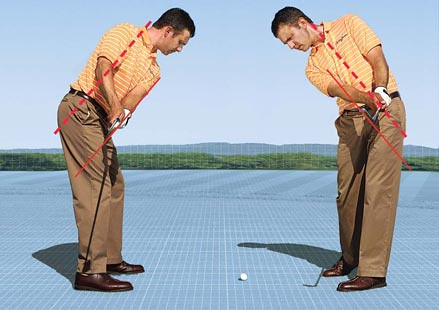 |
| Spine Angle and Face Angle |
I recently posted on the so-called "twistaway" maneuver taught by Brian Manzella (and as it turns out, many others, going all the way back to Joe Dante's Magic Moves book in 1962). As a short review, this is an extreme way for teachers to get hackers and slicers to return to impact with a square to closing club face. It does work, but you can quickly discern that not too many professionals perform a takeaway exactly like that, though some do appear "closed" at the top and many before impact.
Whereas "twistaway" is extreme on purpose for the reasons stated above, there is a less-extreme--though related--school of thought that espouses swinging the club such that the leading edge of the club face stays parallel to the forward bend or "spine angle" throughout the swing. And you can find examples of many modern, professional golfers who swing this way, such as Hunter Mahan, Rickie Fowler, Luke Donald, Rory McIlroy, and Matt Kuchar to name but a few.
In the past, some would have called this "hooding" the club face or taking the club away "closed," but we've come to find out that the club face, when performing the takeaway like this, is actually square to the arc of the swing. The right palm can be thought of as a guide for how the club face is angled in the takeaway.
As an experiment, address the ball and perform your takeaway, stopping before the club shaft is parallel to the ground. Now stand up out of your posture and look at the leading edge of the face. If you performed the takeaway correctly (i.e., matching the face leading edge to your spine angle), the club face leading edge will be vertical when you stand erect. If you opened the face to get the toe of the club to vertical on your takeaway, you'll see that the toe, and thus the leading edge of the club face, is pointing right of vertical (assuming you're swinging right-handed). This means you opened the face going back. Now, many teach this conventionally and the club can be swung well this way, but it requires equal closure coming down to get the club face square again, which can introduce timing issues. Not good for the weekend golfer!
The reason I like this method of swinging the club is that I feel it actually helps keep me in the correct posture, both back and through. When I perform the takeaway and manuever the club face's leading edge to vertical, I tend to stand up out of my posture slightly. But when I keep the leading edge angled roughly 45-degrees to the ground on the takeaway, I have a mental marker for my spine angle. Therefore, I tend to get a slightly steeper shoulder turn (right shoulder pointing my downward), and thus my backswing is flatter (a flatter shoulder turn is usually associated with a more vertical swing plane).
After impact, the club face's leading edge is roughly angled 45-degrees to the sky (the right palm facing in the same direction), again matching the spine angle, when the club is parallel to the ground again (not completely toe-up as often taught), and my spine angle or forward bend again has a reference, so that I don't stand up too quickly out of my posture coming through. As a result, my right shoulder chases all the way through, my shoulders turn perpendicular to my spine angle (a'la Tom Watson's "secret"), and my finish--when performed this way--has my right shoulder pointing at the target and over my left foot! And I still have most of my forward posture, just like the pros. The chest has stayed covering the ball!
There's no need to consciously roll the club face closed through impact to square the face, because the club face is staying square to the arc all the way through; the club face is gradually closing all the way down and through impact. If you use too much hand action coming through (maybe left over from an old, conventional way of swinging), you'll pull or hook the crap out of the ball! Check your divots; a long, narrow toe divot means you're using too much hand action (either flipping or rolling the forearms too much or too soon).
Swinging this way flattens or rounds out the swing plane, without need to think much about it. I believe this is a more consistent way for weekend golfers to swing a club; it takes most of the timing out of the swing.
To check if your club face is square, take the club back until it’s about waist high, then pause your backswing and look at the club head. If the club face is square, it will match your spine angle.
How to Have a Good Takeaway in Golf
To improve your swing path and promote a square clubface at impact, practice making half swings so the club stops parallel to the ground on each side of your body. At these two positions, the leading edge of the clubface should be parallel to your spine. If it is, it means the clubface is rotating correctly and staying square to the swing path. Good path and a square face are the basic ingredients to straight, powerful shots.
Breaking 90: Match the leading edge to your spine angle
Test: Are You On Plane? One way to test your takeaway is by standing upright. If the toe of the club is vertical, your takeaway was on plane.
A narrow divot will mean the club has turned at impact; a hook or slice will be the probable result.
No comments:
Post a Comment